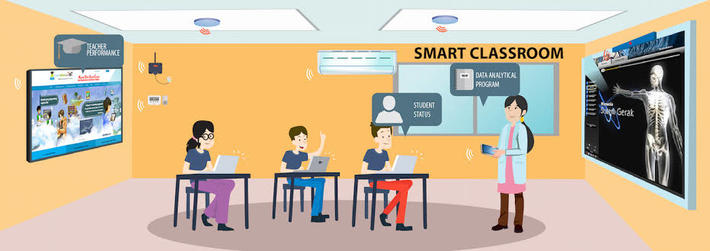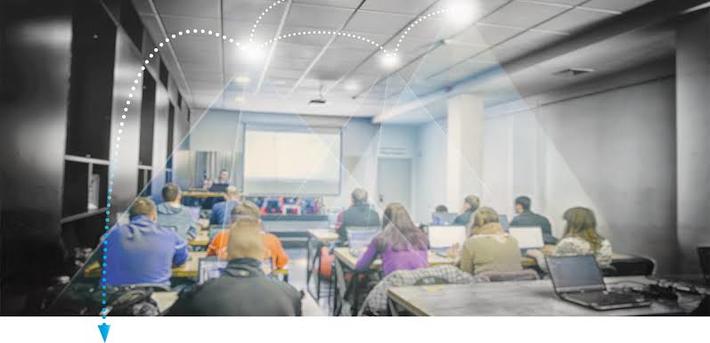As we live through the ever-changing world, education is the sphere that remains surprisingly behind the general rapid advancement. The WEF Future of Jobs Report 2018 states that technological breakthroughs are changing the global labor market, blurring the frontier between human jobs and automated machine tasks and people are still largely unprepared for them.

We’re entering the new paradigm of global interconnectivity where the Internet of Things (IoT) reaches out for previously disconnected offline objects and devices. Although education remains a background sector for IoT by and large, the classroom can benefit from IoT at all stages.
How IoT Can Impact the Classroom?
In another IoT For All article on IoT in education, Hayden Cohen discussed how IoT can help reform the educational system and solve the problems of the shortage of educators and textbooks. In this article, we’ll have a closer look at the direct impact of IoT solutions on classrooms.
IoT-enabled education solutions are allowing the education sector to transform itself for the future. Two obstacles stand in the way: cost and security.Click To Tweet
Most likely, when it comes to IoT-enabled education, we imagine, among other things, a technically-advanced classroom equipped with a smart whiteboard. It’s valid, of course, but IoT for schools begins far before stepping into the classroom. For example, in connected schools, buses can tell parents when they would drop off their children and provide the latter with internet access to do homework, or consume educational content en route to school.
IoT indeed enables innovation, starting with whiteboards and connected school buses, moving toward smart lighting and security cameras—all of which provide real-time data and valuable insights to students, parents, faculty and administration. The most common IoT devices used in the classroom include:
- Interactive whiteboards
- Student ID cards
- Temperature and environmental sensors
- Security cameras with computer vision (say, for detecting weapons)
- Smart, efficient lighting and predictive maintenance for infrastructure
- Smart HVAC systems
- Automated attendance tracking systems (see ID cards)
- Wireless door locks and lockdown protocols
How can all these smart devices help educate smarter and tech-savvy students? Here we will discuss some of the elements of a smart classroom that can create change in the whole educational system.
1. Real-Time Insight and Correction
Insight into a student’s progress, including test results, end-of-term reports and peer reviews, is a cornerstone of education. More Internet-connected devices, such as tablets, paired with data analytics technology, can help educators monitor student attendance and activity during testing and classwork, and ultimately provide more agile and personalized instruction.
2. Better Visualization
The IoT paradigm means interactive content will soon become the norm, and everything from distributing exercises to marking papers will become automated and streamlined. Smart whiteboards and screens can provide for optimized learning and at the same time engage more students into the education process. Visualization of difficult abstract concepts and immediate access to new information on touch or on click can ensure better and more enduring learning.

Augmented Reality (AR) and Virtual Reality (VR) technologies can turn dull fact-based lessons into vivid reproduction of past historical events and engage students in the invention of the combustion engine, or in the discovery of a blood cell, a dinosaur or America.
3. Safer Environment
Smart tech is capable of making schools safer. Wearable wristbands, for example, can register students’ entering and exiting the classroom and school premises. No more sneaking out at lunchtime or between lessons. This measure also helps to prevent intruders and other unauthorized persons entering schools. Besides, smarter security cameras can be trusted to monitor hallways and building perimeters to keep students safe.
4. Efficient Allocation of Resources
In classrooms smart HVAC systems may help save money and energy by functioning only when needed. IoT devices can automatically adjust lighting and audio visual settings to a teacher’s specifications
Challenges for Schools
All of this looks promising, but some educational establishments remain concerned about the implementation of IoT in actual schools. First of all, there are infrastructural problems, like connectivity; then, there are funding problems; then, there are social problems, like acceptance, compliance and generally being scared of 1984-esque big brother monoliths; then, there are security issues, given the early-stage nature of IoT. And other unmentioned and/or unknown problems remain.
At the same time, when devices begin measuring and collecting data from students, they’re automatically putting the security and privacy of students at risk by storing sensitive data in an IoT network (which are prone to cyberattacks). If connected devices penetrate all spheres, this can compromise a student ID linked to an individual’s health records and even to the family’s financial information.
Two Obstacles: Cost and Security
To sum it up, two main concerns about IoT in education are expensiveness and security.
However, students already live in a connected reality: in increasingly smart cities, in connected buses and cars, with smartphones, smartwatches and new and exciting EdTech solutions.
